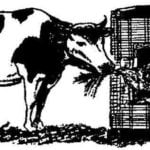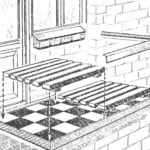Several minutes before the opening of the amateur car design show of 1966 in Moscow, an unusual microcar with an equally unusual trailer attached rolled up to the starting line. Both the car and the trailer were completely flat: the height of the body did not exceed the diameter of the wheel from the early releases of the C3A baby carriage.
This was the car “Tourist-1,” designed and built in the auto-design laboratory of the Young Technicians Station of the Kharkiv House of Food Industry Culture. As sometimes happens, there wasn’t enough time to prepare for the show, and they had to drive to Moscow at night. Valeriy Taranukha, the head of the laboratory, took the wheel, and fourteen hours later, the car safely arrived at Gorky Central Park of Culture and Leisure, literally just in time for the parade’s start. Barely managing to tidy up the car, Valeriy found himself in the center of attention of the specialists gathered at the starting line, and a few hours later, when the jury finished their work, he was awarded two diplomas: one for the original design of the car and the other for driving skill.
Today, “Tourist-1” is a stage completed in the work of young car designers from the Kharkiv House of Food Industry Culture. They have created many interesting microcars, among which stands out a multi-purpose car with a well-thought-out rational design, named “Tourist-2.” As the name suggests, the car is a logical development of the previous one. It takes into account both the positive features and the shortcomings of the first model. The result is a car that is simple and inexpensive to build, incorporating a number of progressive technical solutions, easy to handle and maintain, and, most importantly, serving as a good example for self-taught designers of average qualification.
The main concept in the work of our auto-design laboratory is a thorough study of the industrial components, assemblies, and parts of motorcycles, baby carriages, and cars, with their subsequent use in the design and construction of our own cars. On the one hand, this allows young people to become familiar with the products of domestic and foreign enterprises; on the other hand, it visually demonstrates how to and how not to apply a particular technical solution based on the example of a car that has already been tested in operation. By comparing the suitability of different components in the same design, we develop the ability to think critically, our own “design signature,” without which one cannot start independent developments. Therefore, in the design of our second car, you can find many familiar details from baby carriages, motorcycles, and scooters. They do not need to be manufactured by ourselves, which speeds up the creation of the car and maintains the interest in the work among all its participants.

In “Tourist-2” (Fig. 1), the differential and main gear of the rear axle of the C3A baby carriage, half-axles and hubs of the rear suspension, engine, and two front axles are used, with one modified “for the role of the rear” by installing bearings, hubs, and half-axles instead of swivel knuckles. The front suspension, applied in our car, has the following modifications: spring-hydraulic suspensions of the motorcycle type (from “Pannonia”) are installed instead of standard hydraulic shock absorbers, and the wheels are equipped with brakes using drums and pads, similar to those used on the rear axle of the same baby carriage. For this purpose, the hubs of the front wheels underwent some, in general, uncomplicated modifications, similar to those described in issue No. 11 of “MK” for 1969. The steering mechanism is unchanged from the C3A baby carriage, in assembly with standard steering rods.
In the construction of the rear suspension, the front axle of the C3A is used with the attachment points of the suspension transferred to the frame of the body. The main gear is attached to the rear axle with a differential. The main gear is mounted on brackets and can move forward and backward, allowing for the adjustment of the drive chain. Since the track of the front and rear wheels of the car is the same, and therefore wider than the standard track of the rear wheels of the baby carriage, it was necessary to lengthen the half-axles by welding inserts. Standard shock absorbers of the rear axle are replaced with motorcycle ones.
The wheels and tires are from the baby carriage, and the decorative caps have narrow radial slots, giving them a more elegant appearance.
The car body is all-metal, load-bearing, and welded. To reinforce the front and rear axles, the body is equipped with tubular subframes. It is open, without doors, as the car is primarily designed for use during the summer school holidays.
The engine is located in the front of the car. The transmission to the rear axle is provided by a chain from the IZH motorcycle, slightly lengthened. Rubber rollers are installed on the floor of the body to prevent the chain from sagging. The chain is covered from the top with an easily removable cover. The hood is a cover of the trunk of the “Zaporozhets” car. Under it are the fuel tank, equipped with a fuel level sensor, a regulator relay, an ignition coil, panels for connecting lighting devices, and a fuse block.
In the rear of the car, under the seat, there is a box for tools and the battery. The car seats are semi-rigid, with a 120 mm thick foam cushioning material. The seat covers are waterproof, made of high-quality leatherette. The car’s tent is made of the same material. The tent frame consists of thin-walled steel pipes, connected by a hinge so that the tent can be folded and removed. The front glass can be folded onto the hood, and if desired, quickly removed.

All levers, pedals, and control devices of the car are arranged according to the generally accepted scheme and taking into account the technical conditions for building cars. The clutch and throttle are operated by flexible cables. The front brakes are operated by cables, and the rear ones by a linkage with an equalizing lever. The parking brake acts on one rear wheel. The control levers for the gearbox and reverse are located to the right of the driver, the rods are tubular, with a length adjustment device. The car is equipped with touring tools (a tourist axe and shovel), which are attached to the sides of the body. For the safety of the driver and passenger on the move, the door openings are equipped with easily removable overhangs-straps with carabiners.
The electrical system is 12-volt, from the baby carriage. In addition to the standard lighting scheme, there are two searchlights.
V. TARANUKHA, Kharkiv



